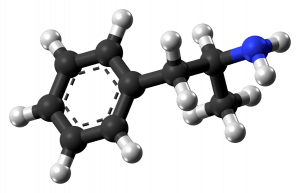
This post was written by IU undergraduate students Catherine DeBruyn, Nuha Zakariya, Hannah Maluvac. It is the first in a series of featured stories written for a ScIU in the Classroom collaboration with Dr. Cathrine Reck in the Department of Chemistry.
Picture this: you are up for a big promotion and it all depends on finishing the massive project your boss gave you in the unreasonable time frame they set. You want that promotion, you need that promotion. So, you ask your friend for some of their AdderallTM, telling yourself “it’s just this once.” Despite its intended prescription for those with attention deficit hyperactivity disorder (ADHD) to enhance focus, AdderallTM is widely abused as a cognitive enhancer, to make your brain work better and faster. Students often use it to help cram for tests and it is even used in the professional world in competitive industries, such as finance and coding, to improve performance. Though AdderallTM can be helpful in many cases, what many people do not know is that it is addictive and can be dangerous when used recreationally. But why is that?


Let’s break it down: AdderallTM is an amphetamine, which is the chemical name describing this particular class of stimulant drugs. Amphetamines have a simple chemical structure. They are composed of a 6 carbon atom ring attached to a carbon chain. The carbon chain functions as a backbone that other groups of atoms can attach to, which then changes how the molecule looks and functions. Specifically, amphetamine has two groups attached to its carbon chain: one is called an “amine,” which has a nitrogen atom and two hydrogen atoms. The other is called a “methyl group,” which is composed of a carbon atom attached to three hydrogens. It can help to think of the overall structure as a key. The ring is the large round part that you hold and the carbon chain is the straight side, while the two groups coming off the chain are like the jagged notches that fit into the tumblers of the lock.
With such a clear, defined structure we can understand many of the effects that amphetamines, such as AdderallTM, may cause. These can include euphoria, increased pulse, hyperactivity, dizziness, and insomnia. These effects occur because of another set of chemicals in our brain, called neurotransmitters, that send signals to communicate and process what is going on in our body and around us. Amphetamine has a really similar chemical makeup to some important neurotransmitters called dopamine and norepinephrine. Like amphetamine, dopamine is also made up of a 6-carbon ring attached to a carbon chain with an amine group. The difference is that dopamine’s carbon ring also has two “hydroxyl” groups, which are each made up of one oxygen atom and one hydrogen atom. Similarly, norepinephrine has just one extra hydroxyl group attached to the carbon chain. This striking similarity means that amphetamines can infiltrate the natural mechanisms of our neurotransmitter systems and cause the neuron storing the neurotransmitters to release more neurotransmitter in the brain. This release of the chemicals stimulates pleasure in the brain’s reward center causing feelings of euphoria, as well as accelerated pulse and other side effects. The amphetamine also inhibits the ability for the real neurotransmitters to be degraded through a natural process, so neurotransmitters continue bouncing around and sending signals to the reward center.

In addition to its similarity with neurotransmitters, amphetamine is also similar to methamphetamine or “meth.” Methamphetamine has the same basic key shape, but a slightly different jagged edge. Methamphetamine is double methylated, which means it has two carbon methyl groups in comparison to amphetamine’s one. When talking about molecules, chemists categorize them as polar and nonpolar. Polar molecules, like water, have a positively charged area and a negatively charged area. Nonpolar molecules have an equal distribution of charge, making the molecule neutral. Accordingly, polar molecules are really good at dissolving other polar molecules and nonpolar molecules can dissolve in other nonpolar molecules. The addition of the extra methyl group makes the methamphetamine more nonpolar. This allows it to quickly cross the nonpolar barrier between our blood vessels and brain, causing it to have more pronounced effects on your body. It also makes methamphetamine more difficult for your body to break down, causing it to stay in your system longer. So, despite these two molecules only differing by one small group of atoms, that second methyl group on methamphetamines makes the drug significantly faster acting, more potent, and more addictive, and, thus, quite a bit more dangerous.
AdderallTM can be extremely helpful for people with ADHD, though the field of science is still not sure how or why. In fact, studies show that while there is minimal risk for people who do have attention disorders, AdderallTM can be addictive for people without ADHD. It is important to encourage people to be careful around these types of stimulants and to inform them that AdderallTM can be very addictive. While it may seem like a lot of people use it and it is “safe,” it is not and should only be used when prescribed by a doctor. Drawing the link between the strong similarities of methamphetamines and amphetamines could help people be more aware and cautious when confronted with the temptation to use amphetamines.
Acknowledgements: We would like to thank Dr. Cathrine Reck, IU Bloomington Professor of Chemistry, for giving us the opportunity to write this post for her class, Organic Chemistry I.
Edited by Alexandra Moussa-Tooks
References:
[1] McMillen, B. A. (1983). CNS stimulants: two distinct mechanisms of action for amphetamine-like drugs. Trends in Pharmacological Sciences, 4, 429-432.
[2] Martin, W. R., Sloan, J. W., Sapira, J. D., & Jasinski, D. R. (1971). Physiologic, subjective, and behavioral effects of amphetamine, methamphetamine, ephedrine, phenmetrazine, and methylphenidate in man. Clinical Pharmacology & Therapeutics, 12(2part1), 245-258.
[3] Murray, J. B. (1998). Psychophysiological aspects of amphetamine-methamphetamine abuse. The Journal of Psychology, 132(2), 227-237.

Leave a Reply